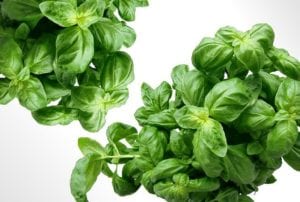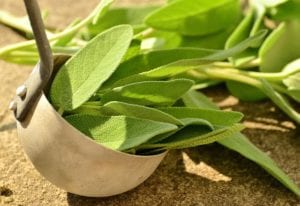
Dehydrating Herbs for Year-Round Flavor
Dehydrating herbs is an easy way to ensure you don’t waste any fabulous flavor and nutrients.
Dehydrating works for just about any leafy herb, but not all recipes work with dried herbs. Try as you might, you really can’t make fabulous green sauces like Pesto, Chermoula, and Chimichurri with dried herbs.
And don’t limit yourself to traditional herbs like parsley, sage, rosemary, and thyme. Celery leaves, chives, lavender blossoms, etc. can be dried the same way.
Dehydrating Herbs
The best thing about dehydrating herbs is you don’t need a fancy dehydrator to do it. You can let Mother Nature do all of the work or speed up the process with your oven.
The amount of moisture in the leaf should be a factor when choosing the method. Herbs with lots of moisture like basil and mint do better with the oven method. Herbs with woodier stems and leaves like rosemary and oregano can be done either way.
Start with freshly picked organically grown herbs. Pick off any withered leaves and bugs. If you need to rinse bugs or dirt off the leaves, be sure to pat them dry to prevent mildew.


Two Methods for Dehydrating Herbs
Method 1 – Air drying woody herbs
Tie a small bundle together with kitchen twine and hang them upside down in a warm, draft-free place where they won’t be disturbed. Depending on the temperature they can be dry in a few days.
My chef brother insists that bay leaves turn bitter if dried on their stems, so I usually remove those from the stem and spread out on a single layer on a cooling rack to air dry.
Method 2 – Oven drying herbs
place an oven-safe cooling rack on a baking sheet. Remove leaves from the stems and spread in a single layer on the rack. Turn the oven on as low as possible, usually 180 degrees Fahrenheit. Dry herbs checking about once an hour to rotate the pan and remove any herbs that have dried. It can take from 2-4 hours to dry completely
When the leaves can easily be crushed between your fingers, they are dry. But, don’t crush them all.


Storing Dried Herbs
Keep the leaves intact and whole as much as possible. Store in airtight containers like zip-to-lock bags, glass jars, etc. Be sure to label them with the type and date.
Dried herbs don’t go bad per se, but they do lose their potency and require more herbs for the same taste. Most will last about a year.

Using dried herbs
In most recipes, you can use a 1:3 ratio of dried herbs to fresh. When you dehydrate the herbs, the water evaporates, and the herbal flavor is concentrated. When a recipe calls for a tablespoon of fresh basil, use one teaspoon of dried.
Crushing the leaves before adding to your recipe will release the remaining oils and increase the flavor. Bay leaves are the exception; put them in whole and remove before eating.
Besides cooking with dried herbs, you can also place them in a tea strainer to make your own tea. Lavender chamomile and mint are especially lovely.
The next time you have an abundance of herbs, don’t let them go bad before you can use them. Just dry them so you can enjoy them for months to come.
- Carrot Leaf Tea – A Perfect Way to Use the Green Tops
- Garlic Kale Soup – Use All That Wonderful Spring Produce
- Tatsoi Mushrooms Asian Delight – Excellent Nutritional Value
- Bell Peppers – Long List of Health Benefits
- Organic Lemons Are Great For Your Health
- Cheesy Kale Cups – Healthy Appetizers
- No Sugar Added Orange Marmalade with Wine
- Rosemary Fermented Carrots – Helps Overall Health
- Carrot Greens – More Vitamin C Than the Root
- 12 Tips to Make Incredible Green Salads
- 15 Radish Recipes to Break Out of the Salad Rut
- Spring Vegetable Risotto – Asparagus, Leeks, and Peas
- Basil Chimichurri – An Amazing Sauce in 5 Minutes
- Catalogna Chicory Salad with Grapefruit and Pumpkin Seeds
- Sauteed Rosemary Beets – Easy Way to Prepare a Superfood
- Swiss Chard with Onions and Vinegar
- Strawberry Rosemary Wine Slushies – Beat The Heat
- Parmesan Rosemary Radishes – Juicy & Lightly Sweet
